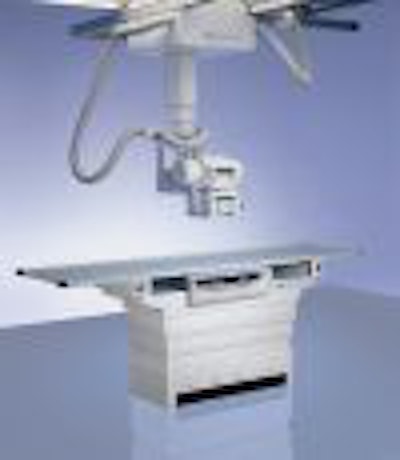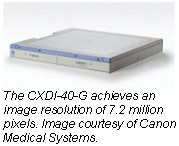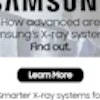
Economies of scale are beginning to work in favor of digital radiography for perhaps the first time. With more developers entering the field, the range of technology options -- from retrofits of existing analog x-ray systems to new state-of-the-art devices -- has never been greater.
In addition, second-generation DR systems are beginning to appear that feature larger image receptors, higher resolution, and increased functionality. All this competition and innovation should pay off for imaging facilities in the form of lower prices as companies strive to establish market share.
Advances also continue in computed radiography. CR’s range and functionality have broadened considerably, and RSNA attendees will witness the continuing investments that imaging vendors have been making to this technology. This year sees the introduction of smaller, faster, and less-expensive systems, as well as units that branch out into new territory, such as digital mammography.
Radiology facilities are looking to both CR and DR for help in dealing with the ongoing shortage of qualified personnel, particularly radiologic technologists. The hope is that digitizing the last major analog modality will enable workflow improvements that help imaging centers and radiology departments function with smaller staffs. While the jury is still out on the issue, look for imaging vendors to continue to emphasize workflow improvements with their new products.
Agfa HealthCare
Booth # 7114
Agfa will be debuting a modular line of CR systems designed for small- and medium-size hospitals and clinics. The product line, Initia, is composed of four configurations.
The Initia CR 1000 basic system comes with a CR digitizer, PC, and network switch, and is targeted at facilities that already have a printer. The next option in the line includes a Drystar 3000 printer in addition to the CR digitizer, PC, and network switch. Agfa is marketing the product to users who prefer 1:1 images and full-size thoracic images.
The third offering in the product line provides a Drystar 4500 printer along with the other components. The company is pointing this system toward users who are comfortable with smaller images and want a lower-priced print option.
The final configuration in the Initia suite includes an Impax Basix entry-level PACS in addition to the digitizer, PC, and network switch. The Greenville, SC-based firm is touting this model as a robust solution for small- to mid-size facilities that want to make the first move from film to digital imaging.
In other CR news from the vendor, Agfa will be marketing its portfolio of women’s care solutions under the name Embrace. This includes a multipurpose CR digitizer with improved image quality to meet the demands of mammography specialists, according to the company.
Canon Medical Systems
Booth # 3537

CXDI-40G is an amorphous silicon flat-panel sensor that achieves a resolution of 7.2 million pixels. It produces a 17 x 17-inch image size and has a preview image-access time of three seconds after x-ray exposure, according to the developer.
The unit can be installed in a table or used with an upright or universal stand. It can also be used in trauma systems, universal lateral systems, and mobile systems. Canon plans to display the new product in a variety of different radiographic applications. The CDXI-40G, which has a pending FDA 510(k) clearance, will be available worldwide in 2003, according to Canon.
Cares Built
Booth #3453
Cares Built of Keyport, NJ, is showcasing its Clarity 7000 digital detector at this year’s meeting. The detector’s modular design enables it to be retrofitted to most existing buckys.
The unit, which received U.S. Food and Drug Administration 510(k) marketing clearance in late 2001, boasts a resolution up to 7 line pairs per millimeter. Pricing on the system, depending on retrofit configuration, ranges from $220,000 to $330,000.
Eastman Kodak Health Imaging
Booth # 1945
In digital x-ray, the Rochester, NY-based vendor will be showing its DirectView CR systems, which support single- or multiple-cassette processing and include remote operations panels to allow data entry and quality control in the exam room, Kodak said.
DirectView CR systems are bolstered by Kodak's EVP software for image enhancement, as well as other software that automates quality control testing and allows for data entry to be conducted by remote clerical staff instead of technologists, according to the vendor.
The vendor will also be debuting its DirectView DR 5100 platform at the conference, which extends its digital radiography product portfolio. Kodak's DirectView DR systems now include EVP and the same user interface as DirectView CR.
In mammography, Kodak said it would show its recent X-Omat EX II developer and replenisher. Highlights in general radiography and specialty radiography film include the company’s X-Sight and InSight film systems, Kodak said.
Edge Medical Devices
Booth # 1759
Flat-panel DR developer Edge is presenting a new split-console configuration and image processing for its Quix DR retrofit line. With the new flexible configuration, the monitor and console may be placed in one location and the CPU in another, helping facilities make the most of limited space in the technologists’ shielded work area.
The new processing software offers a range of advanced features integrated into the Quix operator console, which the Hackensack, NJ-based firm will also be demonstrating at the conference. The firm will also be displaying the latest clinical images acquired with its scanned matrix array technology (SMART) detector.
Firm pricing on the Quix retrofit kit is not yet available; however, the SMART technology will be available for nearly half the cost of traditional flat-panel DR, making it similarly priced to CR, said company president, Robert Sohval.
Fujifilm Medical Systems USA
Booth #2709
Fuji will showcase its new compact CR unit at this year’s RSNA meeting. The unit will provide the productivity throughput of a DR system at a CR price, according to the company.
The Stamford, CT-based company is also branching its Flash IIP into two new products to accommodate a broader range of customers. The first product, Flash Lite, will provide users with a more flexible product for less money. Its functions include image viewing, basic image editing, and optional upgrades with deluxe quality assurance, magnified image display, full-screen display, and image composition.
The second product, Flash IIP Plus, is a more robust version of Flash Lite that will have stitching and energy subtraction (ES) capabilities, as well as Image Intelligence processing, which provides better image quality, according to Fuji. Flash IIP Plus can handle mammography and ES, and image processing, and can be connected to a high-quality monitor (1600 x 1200 or 2048 x 1568 resolution).
Flash Lite saves images onto a local database, performs database queries, and sends images to a printer, PACS, or a centralized Flash IIP Plus. Flash IIP Plus displays a list of patient studies from Flash Lite devices on its network, and these images are saved to a hard drive at its location.
Go to page:
Agfa through Fuji
GE through Toshiba



















